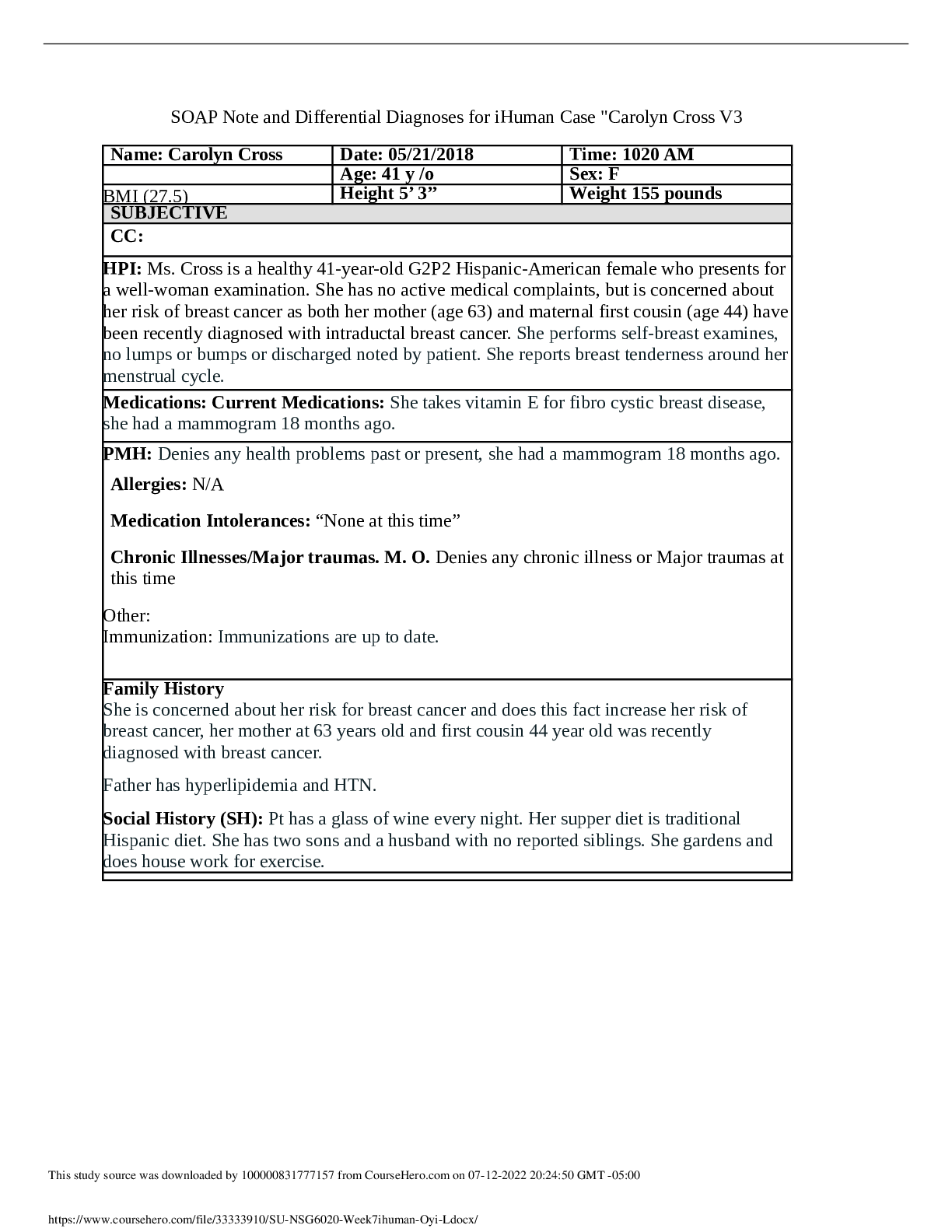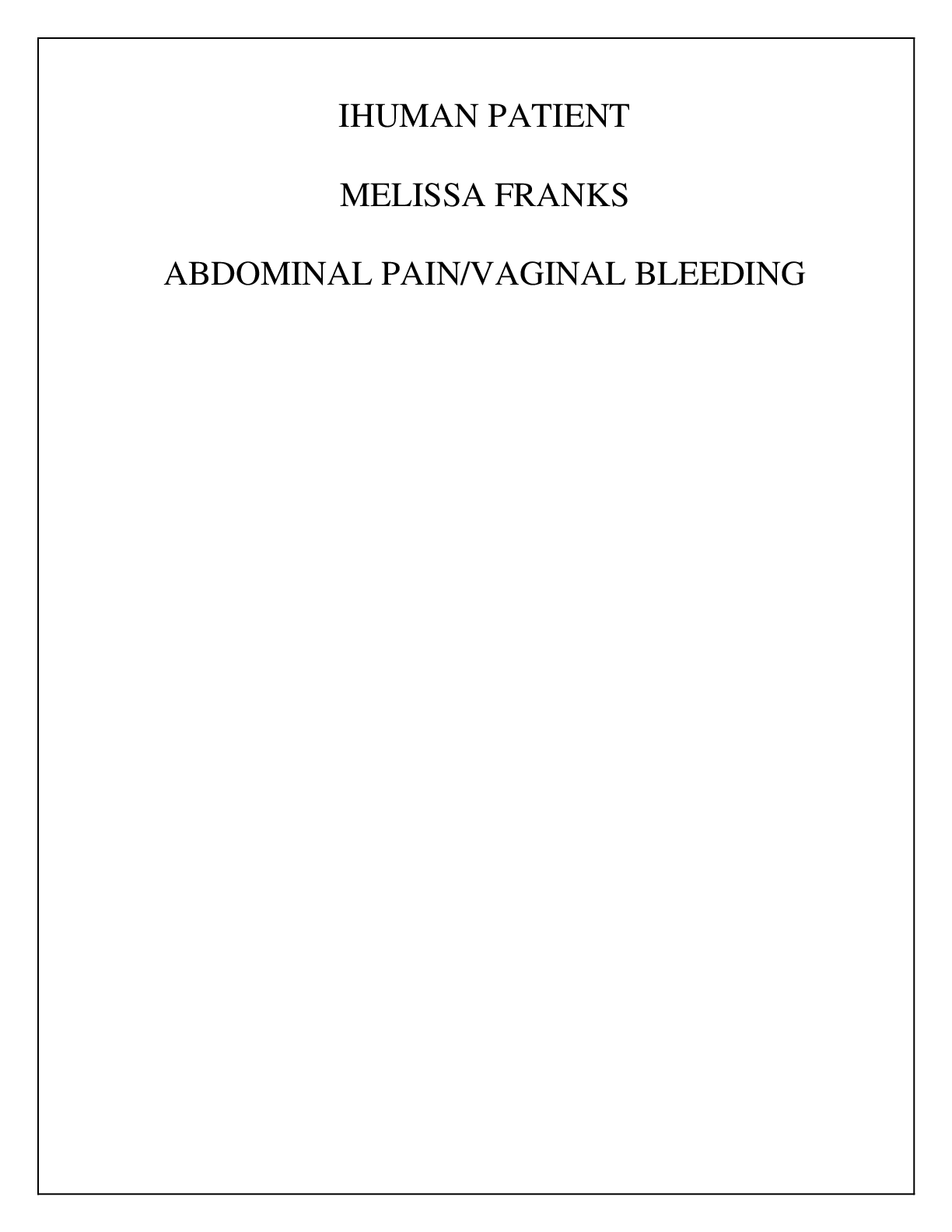NR 602 Week 1, Well-Woman Exam for Kayla
Document Content and Description Below
NR 602 Week 1, Well-Woman Exam for Kayla Chamberlain College of Nursing Well-Woman Exam for Kayla Patient Information: KF, 37, F, Latin American S. CC (chief complaint): “I am here for a phy... sical exam.” Reports fatigue and trouble falling and staying asleep at night. HPI: Onset: About 8 weeks ago Location: n/a Duration: daily at night for sleep problems, constant for fatigue Characteristics: Hard time falling asleep and staying asleep. Feeling tired all the time. Aggravating Factors: Stress, financial worries, and sleeping in the same room as children. Relieving Factors: No information given. Treatment: Taking Advil PM and drinking a glass of wine every night to help with sleep. Current Meds: No current medications. Takes Advil PM at night or sleep prn. Allergies: NKDA. PMHx: In general good health. No surgeries or hospitalizations other than childbirths. Four Pregnancies: 3 births (1 pre-term, 2 C-sections). One miscarriage at 10 wks at the age of 16. PCOS diagnosed as teenager with irregular menses. Gestational diabetes with last pregnancy. No information given for immunization status. Doesn’t know date of last tetanus. Social History: Recently separated from husband. Moved to the area with her children to live with parents. Three children, ages 13 months, 5 yrs, and 15 yrs. Trying to resolve marital issues, in marital counseling. Reports financial worries, stress and ongoing fatigue. Former smoker, smoked 1 PPD x 15 yrs, quit smoking 18 months ago when pregnant. Drinks a glass of wine every night to sleep. Does not exercise routinely. Often skips breakfast and lunch. Family diet consists largely of processed, quick food. Revised 4/16Chamberlain College of Nursing Family History: Mother with hyperlipidemia, Type 2 DM, and HTN. Father with HTN, hyperlipidemia, and an MI with stenting 2 yrs ago. Children all healthy. ROS: CONSTITUTIONAL: (+) fatigue, (+) stress, (+) unable to fall asleep and stay asleep CARDIOVASCULAR: no information given RESPIRATORY: no information given GASTROINTESTINAL: (+) skips breakfast and lunch, (+) consume quick, processed food daily. REPRODUCTIVE: (+) No menses since birth of last child NEUROLOGICAL: no information given MUSCULOSKELETAL: no information given HEMATOLOGIC: no information given PSYCHIATRIC: (+) stress ENDOCRINOLOGIC: no information given O. Vital signs: height: 155 centimeters, weight: 65.5 kilograms. B/P: 130/76, HR: 82, T: 98.7, Resp: 16, SpO2: 97%. BMI 27.3 (Overweight) General: Awake, alert, appropriate; well groomed; tearful at times throughout the exam; HEENT: head normocephalic; Conjunctiva clear, non-icteric, PERRLA, EOM’s intact; tympanic membranes intact, unremarkable; nares patent, unremarkable bil; pharynx unremarkable tonsils 1/4 bil; neck supple w/o lymphadenopathy. Skin: warm, dry, intact; Cardiopulmonary: Heart RRR w/o murmur; lungs CTA throughout; respirations even and unlabored. Peripheral pulses reg., equal Breast Exam: Breasts of normal development bil. Areola unremarkable. Nipples without discharge or tenderness. No masses or tenderness upon palpation Abdomen: abdomen, soft, with normoactive bowel sounds throughout; tenderness to palpation in the super-pubic area, no masses or organomegally. External Genitalia: Mons intact with normal hair distribution, labia majora, minora, clitoris intact, Bartholin’s and Skene’s glands. Intact. No Revised 4/16Chamberlain College of Nursing piercings. No hymen. Vagina: Pink, moist, with rugae, no odor, tone good. No rectocele, cystocele, or discharge. Cervix: pink with multi-parous patent os, no lesions, sl. anterior and freely mobile without tenderness. Uterus: small, firm, pear shaped, midline, smooth, mobile, non-tender uterus. Adnexa: present, smooth, non-tender. Diagnostic Results: Urinalysis in the office: Cloudy amber yellow urine, Sp. Gr. 1.010, positive WBCs, nitrites, and leukoesterase; negative for RBCs, glucose, and ketones. A. Primary Diagnosis Encounter for gynecological examination (general) (routine) with abnormal findings (ICD 10 Z01.411) - This is a routine well woman check. Secondary Diagnoses: Urinary Tract Infection (ICD 10 N39.0) - UTIs are infections of the urinary tract mainly caused by a bacterial infection. S&S: Urinary frequency, burning and urgency, dysuria, urge incontinence, and suprapubic pain. Pertinent negatives include no reports of above UTI signs and symptoms. Pertinent positives include a positive urine dipstick for positive WBCs, leukocytes, and nitrites and tenderness to palpation in the super-pubic area, (Kim, Lloyd, Condren, & Miller, 2015). Polycystic Ovarian Syndrome (ICD 10 E28.2) - A hormonal imbalance disorder that affects the menstrual cycle and leads to cysts forming in the ovaries. Symptoms include irregular periods, cysts on ovaries, excess body hair, and weight gain (Williams, Mortada, & Porter, 2016). Pertinent positives include report of history of PCOS and amenorrhea as reported by patient. No pertinent negatives. Secondary Amenorrhea (N91.1) - In secondary amenorrhea it is the absence of periods for at least 3 months in females who have regular periods or the absence of periods for 6 months for females who have irregular periods (Klein & Poth, 2013). Pertinent positives: Kayla reports h/o PCOS and has not had a period since the birth of her last child. No pertinent negatives. Inappropriate Diet and Eating Habits (ICD 10 Z72.4) - Unhealthy diet and eating habits that can affect a person’s health, physically and mentally. Foods that are high in calories but have low nutritional value are harmful and can lead to malnutrition, development issues, obesity, and other health risks. Kayla and her children consume a lot of quick, processed food, juice and soda. Nutrients provide energy for the body which helps us focus and get through the day as well as boost our immune system (Ballard, 2013, Shridar et al, 2015). Adequate nutrition is Revised 4/16Chamberlain College of Nursing recommended for everyone. Inadequate nutrition can lead a person to feel fatigued and tired. Adequate nutrition helps maintain your immune system and promote normal body processes such as thinking and sleeping (Ballard, 2013, Shridar et al, 2015). Pertinent positives include no reported history poor eating habits or being overweight. Pertinent negatives are highlighted above. Obesity (ICD 10 E66) - A condition of excess body fat and weight that predisposes a person to multiple health risks. Pertinent positives include an unhealthy diet and high BMI. No pertinent negatives (Tremmel, Gerdtham, Nilsson, & Saha, 2017) Acute Stress Reaction (ICD 10 F43.0) - This is a psychological condition that arises as a reaction to recent traumatic or stressful events. It occurs within four weeks of the traumatic event happening (Kavan, Elsasser, & Barone, 2012). Kayla just recently separated from her husband forcing her and her children to move in with her parents. The marital separation, financial worries, and change in living n environment can be very stressful for anyone. She may be having an acute stress reaction. Acute stress reaction can have many different clinical manifestations including anxiety, depression, fatigue, memory problems, sleep problems, headaches and gastrointestinal problems to name a few (Kavan, Elsasser, & Barone, 2012). Having fatigue, sleep disturbances, and feeling stressed, worried, and anxious are diagnostic for acute stress reaction using the DSM-5 criteria. Pertinent negatives highlighted above. Pertinent positives include no reported prior history of stress, anxiety, or depression. Differential Diagnoses Anxiety Disorder, unspecified (ICD 10 F41.9) - This is a psychological condition characterized by having high levels of constant anxiety, worry, or fear (Locke, Kirst, & Shultz, 2015). The psychological and emotional consequences of being anxious can manifest itself into physical symptoms. S&S: high levels of worrying, restlessness, irritability, sleep disturbance, muscle tension, difficulty concentrating, gastrointestinal symptoms, and fatigue (Locke, Kirst, & Shultz, 2015). Kayla just recently separated from her husband and had to make big move hours away to live with her parents. The constant financial worries, change in environment, and stress makes her at risk for anxiety disorder. Pertinent negatives highlighted above. Pertinent positives include no reported prior history of stress, anxiety, or depression. P. Dx: Routine lab tests for CBC, CMP, Hgb A1C, thyroid panel (Schuiling, & Likis, 2013). Send urine out for a culture. Urine culture is the gold standard for confirming the present of a UTI (Najeeb, 2015; Ferri, 2016). We also need a pregnancy test, hormone tests (LH, FSH, TSH, and prolactin levels) and a pelvic ultrasound to figure out the cause of her amenorrhea (Klein & Poth, 2013). Administer GAD-7 scale to screen for anxiety and treat as needed (Locke, Kirst, & Shultz, 2015). Revised 4/16Chamberlain College of Nursing Rx: TMP/SMX 160/800 tablets (Kim, Lloyd, Condren, & Miller, 2015) Take one tablet twice daily for 3 days. Disp # 6 tablets, no refills IDSA guidelines recommending trimethoprim–sulfamethoxazole (TMP/SMX) as first-line therapy (Kim, Lloyd, Condren, & Miller, 2015). Education: For UTI Drink plenty of fluids (Dunphy et al, 2015). Wear cotton underwear and avoid tight pants to reduce moisture (Dunphy et al, 2015). Wipe from front to back (Dunphy et al, 2015). Void before and after sexual activity (Dunphy et al, 2015). Return to office sooner is symptoms worsen (Kim, Lloyd, Condren, & Miller, 2015). Education for Nutrition: Lose weight and exercise daily. Walk at least 30-60 minutes a day (Ballard, 2013, Shridar et al, 2015). Eat well-balanced meals that consist of fruits, vegetables, and grain products (Ballard, 2013, Shridar et al, 2015). Limit salt and fat (Ballard, 2013, Shridar et al, 2015). Avoid caffeine, sodas and fruit juices (Ballard, 2013, Shridar et al, 2015). Avoid candy and sugary desserts (Ballard, 2013, Shridar et al, 2015). Limit fast food, junk food, and processed food (Shridhar et al, 2015). Drink at least 8 ounces of milk daily (Ballard, 2013, Shridar et al, 2015). Other education May need tetanus shot (if it has been more than 10 years) or flu vaccine if indicated Sleep at least 7-9 hours a day (Ramar & Olson, 2013). Referral/Consults: Gynecology referral for amenorrhea and possible repeat Pap test if it was abnormal (Schuiling, & Likis, 2013). Referral to psychotherapy to help with anxiety and stress (Locke, Kirst, & Shultz, 2015). Revised 4/16Chamberlain College of Nursing Follow up: Return for follow up appointment in 2 weeks to make sure infection has cleared. Return sooner if symptoms do not improve as indicated above (Kim, Lloyd, Condren, & Miller, 2015). Patient Information: JF, 5, F, Latin American S. CC (chief complaint): “here for a physical exam.” Mother also reports that patient has difficulty going to bed each night and staying asleep. Patient wakes up in the middle of the night to play. HPI: Onset: about 2 months ago Location: n/a Duration: daily at night Characteristics: n/a Aggravating Factors: none reported Relieving Factors: none reported Treatment: None reported Current Meds: Chewable Children’s MVI with Fe daily. Allergies: NKDA. PMHx: Healthy with no recent illnesses. No hospitalizations. Full-term baby born by C-section. Weighed 7 lbs, 4 oz at birth. Mother smoked 1 PPD during pregnancy. No complications during pregnancy. Immunizations up to date. Vaccination History: Birth – Hep B, 2 months – DTaP, COMVAX, PCV13, IPV, 4 months - DTaP, COMVAX, PCV13, IPV, 6 months – DtaP, PCV 13, IPV. Hep B, 12 months – MMR, Varicella, Hep A, PCV 13, 18 months – DtaP, Hep A Social History: Middle child, 15 y/o sister and 13 month old brother. Parents separated recently. Moved in with grandparents 8 wks ago with mom and siblings. Father lives several hours away. Starting kindergarten fall at the local elementary school. Eats three meals a day, 2 snacks daily in the afternoon and at bedtime. Diet consists greatly of juice, soda, and processed or quick foods. Revised 4/16Chamberlain College of Nursing Mother reports difficulty putting her to sleep and keeping her asleep at night. Wakes up to play in the room at night. Mother brushes her teeth twice a day. Always sits in carseat in the car. Plays vigorously indoors and outdoors. Family History: Mother used to smoke and father still currently smokes. Mother quit smoking 18 months ago. No PMH for father. Mother with gestational diabetes and PCOS. Siblings healthy. ROS CONSTITUTIONAL: no information given CARDIOVASCULAR: no information given RESPIRATORY: no information given GASTROINTESTINAL: (+) consumes quick, processed food daily, (+) bedtime snack, (+) juice and soda PSYCHIATRIC: (+) sleep difficulties ENDOCRINOLOGIC: no information given O. Vital signs: height: 110 centimeters, weight: 29 kilograms, BMI above 95th percentile. B/P:102/60, T: 98.2, HR: 94 BMP/reg., Resp: 18, reg, non-labored, SpO2: 99%. Growth Chart Parameters (75% percentile for height, >95% for weight) General: Cooperative, talkative, appropriate HEENT: head normocephalic atraumatic, hair thick and distributed throughout entire scalp; Conjunctiva clear, non-icteric, PERRLA, EOM’s intact; fundoscopic exam unremarkable; vision by Snellen exam 20/40 in each eye, 20/30 together; tympanic membranes intact, unremarkable; pinna/tragus w/o tenderness; nares patent, unremarkable bil; pharynx unremarkable tonsils 2/4 bil; primary tooth eruption to include first molars upper and lower; no loose teeth; oral exam unremarkable; neck supple w/o lymphadenopathy; thyroid small, firm, equal bilateral Cardiopulmonary: Heart RRR w/o murmur, peripheral pulses reg., equal., intact bil radial and pedal Respiratory: lungs CTA throughout; respirations even and unlabored Gastrointestinal: abdomen sl. rounded normoactive bowel sounds throughout, soft, non-tender, no masses, or organomegaly Revised 4/16Chamberlain College of Nursing Genitorurinary: labia majora and minora intact, no erythema or discharge. Reproductive: Tanner 1 breasts and pubic area. Musculoskeletal: MAE. Able to do deep knee bends; hop on one foot on right leg but not left with any balance, tries but tumbles; able to balance on each leg for 10 seconds. Cognitive Development: Able to state name and age; can write her own name; able to recall three friends names; knows all colors and can count to 13; dresses herself and has control of bowels and bladder; verbal throughout exam; all of speech clear and recognizable. A. Primary Diagnosis Routine child health examination without abnormal findings (ICD 10 Z00.129) - This is a child well check exam with no abnormal findings. Encounter for Immunizations (ICD 10 Z23) - This is an office visit for vaccines to be administered. Jo will need booster vaccines prior to starting kindergarten (DTap, IPV, MMR, Varicella, and flu vaccine if necessary). May also need a TB test (Hay, Levin, Deterding, & Abzug, 2014). Secondary Diagnoses: Obesity (ICD 10 E66) - A condition of excess body fat and weight that predisposes a person to multiple health risks. Pertinent positives include an unhealthy diet and high BMI. No pertinent negatives (Tremmel, Gerdtham, Nilsson, & Saha, 2017) Inappropriate Diet and Eating Habits (Z72.4) - Unhealthy diet and eating habits that can affect a person’s health, physically and mentally. Foods that are high in calories but have low nutritional value are harmful and can lead to malnutrition, development issues, obesity, and other health risks. Nutrients provide energy for the body which helps us focus and get through the day as well as boost our immune system (Ballard, 2013, Shridar et al, 2015). Adequate nutrition is recommended for everyone. Inadequate nutrition can lead a person to feel fatigued and tired. Adequate nutrition helps maintain your immune system and promote normal body processes such as thinking and sleeping (Ballard, 2013, Shridar et al, 2015). Pertinent positives include no reported history poor eating habits, being overweight, or feeling fatigue. Pertinent negatives are highlighted above. Sleep disorder, unspecified (ICD 10 G47.9) - This is a disrupted sleep pattern. Kayla reports that she has a hard time putting Jo to bed and keeping her asleep. Jo wakes up in the middle of the night to play. These are the pertinent positives. Pertinent negatives include no reported history of sleep problems for Jo. No getting adequate sleep can affect Jo in many ways. We need to promote sleep hygiene, look at her diet, and ask her questions to find out what can be affecting her sleep patterns (Carter, Hathaway, & Lettieri, 2014). Revised 4/16Chamberlain College of Nursing Differential Diagnoses Acute Stress Reaction (ICD 10 F43.0) - This is a psychological condition that arises as a reaction to recent traumatic or stressful events. It occurs within four weeks of the traumatic event happening (Kavan, Elsasser, & Barone, 2012). Jo’s mother and father just recently separated which forces her mom, siblings, and her to move in with their maternal grandparents. This can be very traumatic and stressful for a child. She may be having an acute stress reaction. Acute stress reaction can have many different clinical manifestations including anxiety, depression, fatigue, memory problems, sleep problems, headaches and gastrointestinal problems to name a few (Kavan, Elsasser, & Barone, 2012). Pertinent negatives highlighted above. Pertinent positives include no reported prior history of stress, anxiety, or depression. Separation Anxiety (ICD 10 S93)- This is anxiety that arises from being separated from loved ones. The anxiety experienced can manifests itself into an array of symptoms. (Milrod et al, 2014). Jo’s mother and father recently separated therefore she is no longer seeing her father daily. This separation is very stressful and traumatic for a child. Separation anxiety leads to panic and fear that can lead to symptoms of sleep problems, changes in personality and/or behaviors, and physical complaints such as headaches and gastrointestinal problems (Milrod et al, 2014). Pertinent positives include no reported history of separation or behavioral issues. Pertinent positives are highlighted above. P Diagnostics: Hearing test to assess hearing acuity, an in-office Hgb test to check for anemia (Hay, W., Levin, M., Deterding, R., & Abzug, M. (2014). Rx: continue Zytrec for allergies Administer vaccines (DTap, IPV, MMR, Varicella, and flu vaccine if necessary). Tb test to be given (Hay, Levin, Deterding, & Abzug, 2014). Education: Always wear a helmet when riding a bike (AAP, 2017). Limit TV watching and media use to no more than 2 hours a day (AAP, 2017). Avoid tobacco exposure in children (AAP, 2017). Make sure your child engages regular physical activity daily of at least 60 minutes a day (AAP, 2017) Make sure your child eat well-balanced meals that consists of fruits, vegetables, and grain products (Ballard, 2013, Shridar et al, 2015; AAP, 2017). Revised 4/16Chamberlain College of Nursing Make sure your child eat well-balanced meals that consists of fruits, vegetables, and grain products (Ballard, 2013, Shridar et al, 2015; AAP, 2017). Limit salt and fat (Ballard, 2013, Shridar et al, 2015; AAP 2017). Avoid caffeine, sodas and fruit juices (Ballard, 2013, Shridar et al, 2015; AAP 2017). This may contribute to your child’s sleep problems. Avoid candy and sugary desserts (Ballard, 2013, Shridar et al, 2015; AAP 2017). Limit fast food, junk food, and processed food (Shridhar et al, 2015; AAP 2017). Drink at least 8 ounces of milk daily (Ballard, 2013, Shridar et al, 2015). Make sure your child sleeps at least 10-12 hours a day (AAP, 2017). Referral/Consults: none needed Follow up: none needed References American Academy of Pediatrics (2017). Bright futures: Guidelines for health supervision of infants, children, and adolescents: Middle childhood- 5-10 years of age. Retrieved from https://brightfutures.aap.org/Bright%20Futures%20Documents/17-Middle_Childhood.pdf Ballard, K. T. (2013). Improved nutrition through school food programs. Pediatric Annals, 42(9), 376-378. doi:http://dx.doi.org.proxy.chamberlain.edu:8080/10.3928/00904481-20130823-12 Carter, K. A., Hathaway, N. E., & Lettieri, C. F. (2014). Common sleep disorders in children. American Family Physician, 89(5), 368-377. Dunphy, L. M., Winland-Brown, J. E., Porter, B. O., & Thomas, D. J. (2015). Primary care: The art and science of advanced practice nursing (4th ed.). Retrieved from http://online.vitalsource.com Ferri, F. F. (2016). Ferri’s clinical advisor 2017: 5 books in 1. Elsevier - Health Service Hay, W., Levin, M., Deterding, R., & Abzug, M. (2014). Current diagnosis and treatment: Pediatrics (22nd ed.). Retrieved from http://online.vitalsource.com Revised 4/16Chamberlain College of Nursing Kavan, M.G., Elsasser, G.N., & Barone, E.J. (2012). The physician's role in managing acute stress disorder. American Family Physician, 86(7), 643-649. Kim, M., Lloyd, A., Condren, M., & Miller, M. (2015). Beyond antibiotic selection: concordance with the IDSA guidelines for uncomplicated urinary tract infections. Infection, 43(1), 89-94. doi:10.1007/s15010-014-0659-4 Klein, D. A., & Poth, M. A. (2013). Amenorrhea: an approach to diagnosis and management. American Family Physician, 87(11), 781-788. Locke, A., Kirst, N., & Shultz, C. (2015). Diagnosis and management of generalized anxiety disorder and panic disorder in adults. American Family Physician, 91(9), 617-624. Milrod, B., Markowitz, J., Gerber, A., Cyranowski, J., Altemus, M., Shapiro, T., Hofer, M., & Glatt, C. (2014). Childhood separation anxiety and the pathogenesis and treatment of adult anxiety. The American Journal of Psychiatry, 171(1), 34-43. Najeeb, S., Munir, T., Rehman, S., Hafiz, A., Gilani, M., & Latif, M. (2015). Comparison of urine dipstick test with conventional urine culture in diagnosis of urinary tract infection. Journal Of The College Of Physicians And Surgeons--Pakistan: JCPSP, 25(2), 108-110. doi:02.2015/JCPSP.108110 Ramar, K., & Olson, E. J. (2013). Management of common sleep disorders. American Family Physician, 88(4), 231-238. Shridhar, G., Rajendra, N., Murigendra, H., Shridevi, P., Prasad, M., et al. (2015) Modern diet and its impact on human health. Journal of Nutrition and Food Sciences, 5(6). doi:10.4172/2155- [Show More]
Last updated: 1 year ago
Preview 1 out of 11 pages
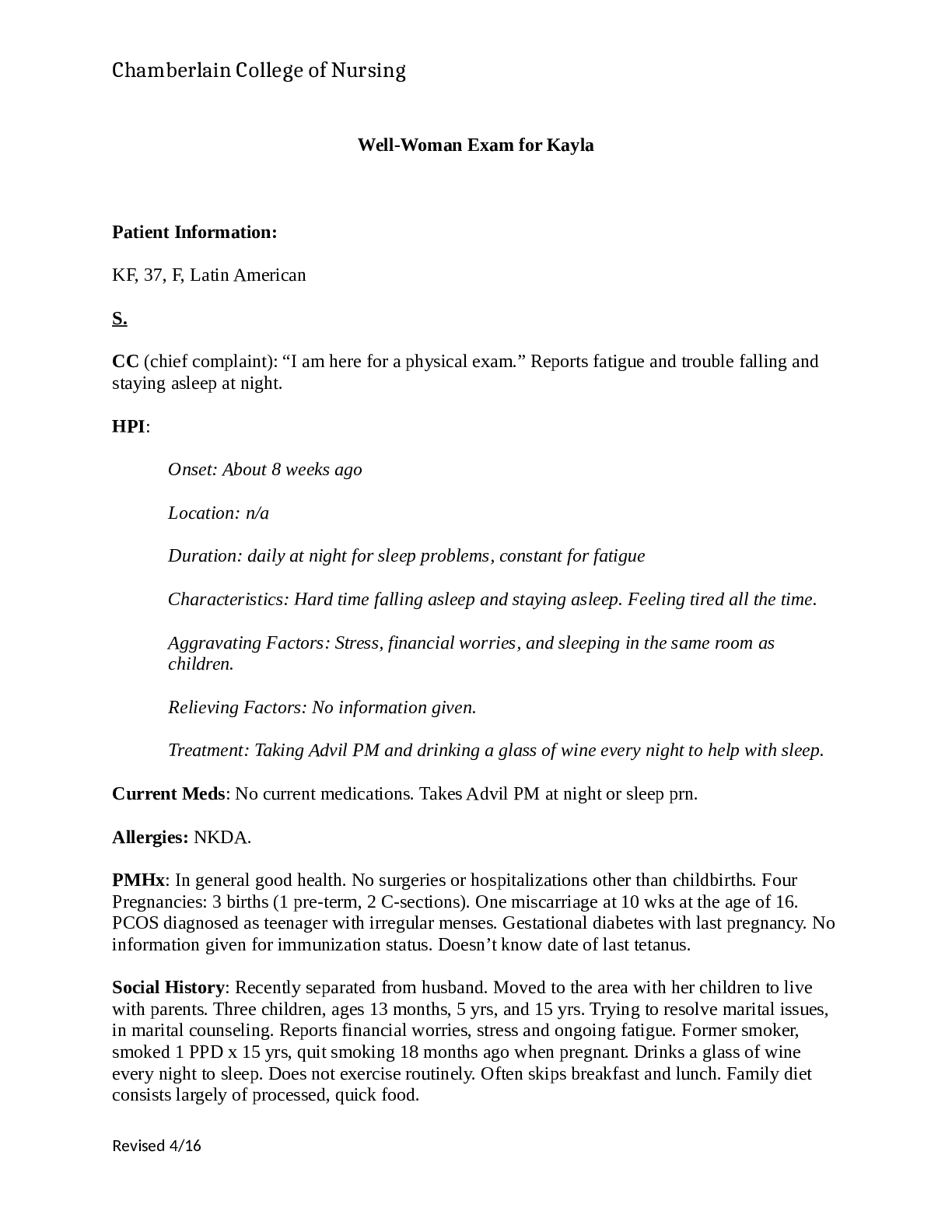
Reviews( 0 )
Document information
Connected school, study & course
About the document
Uploaded On
Nov 07, 2022
Number of pages
11
Written in
Additional information
This document has been written for:
Uploaded
Nov 07, 2022
Downloads
0
Views
31


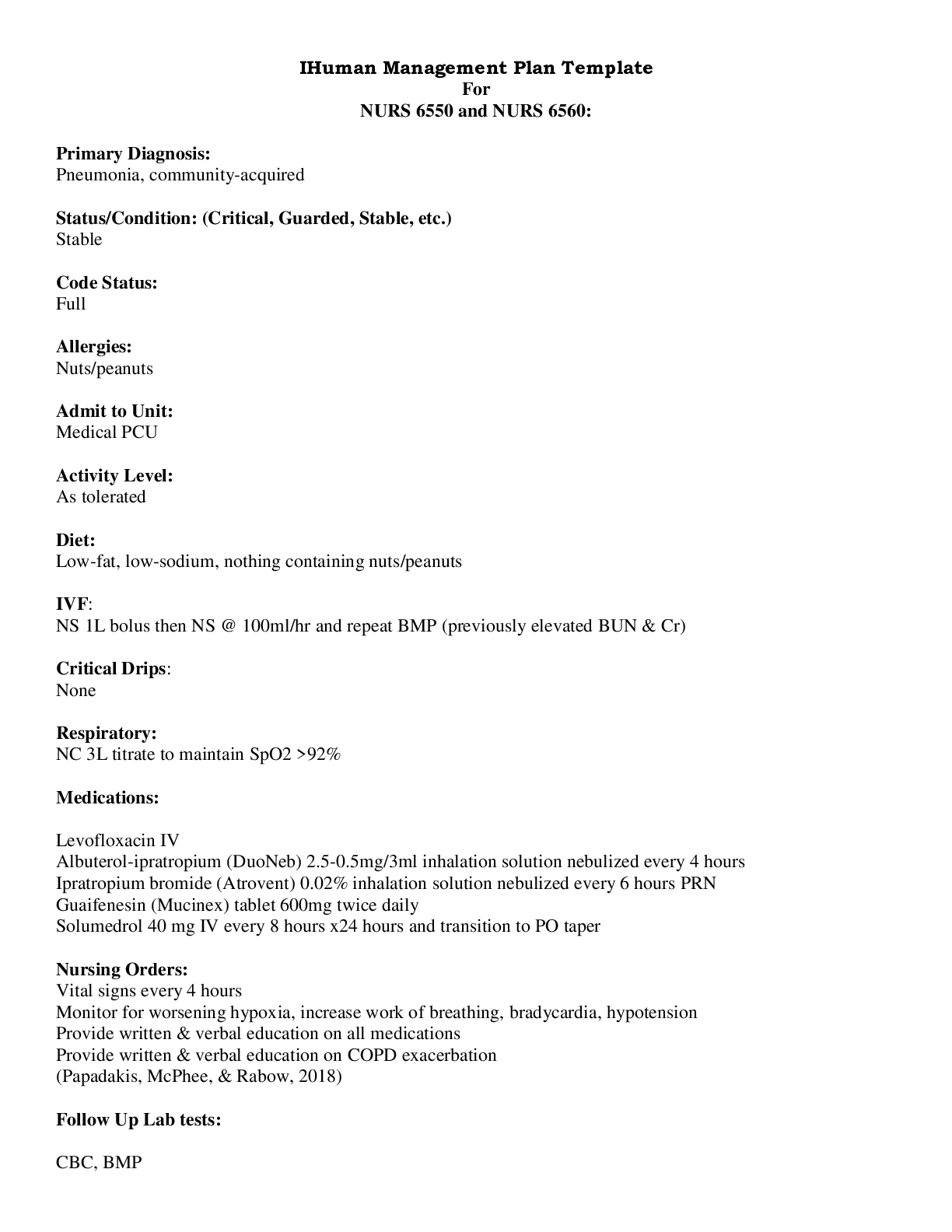


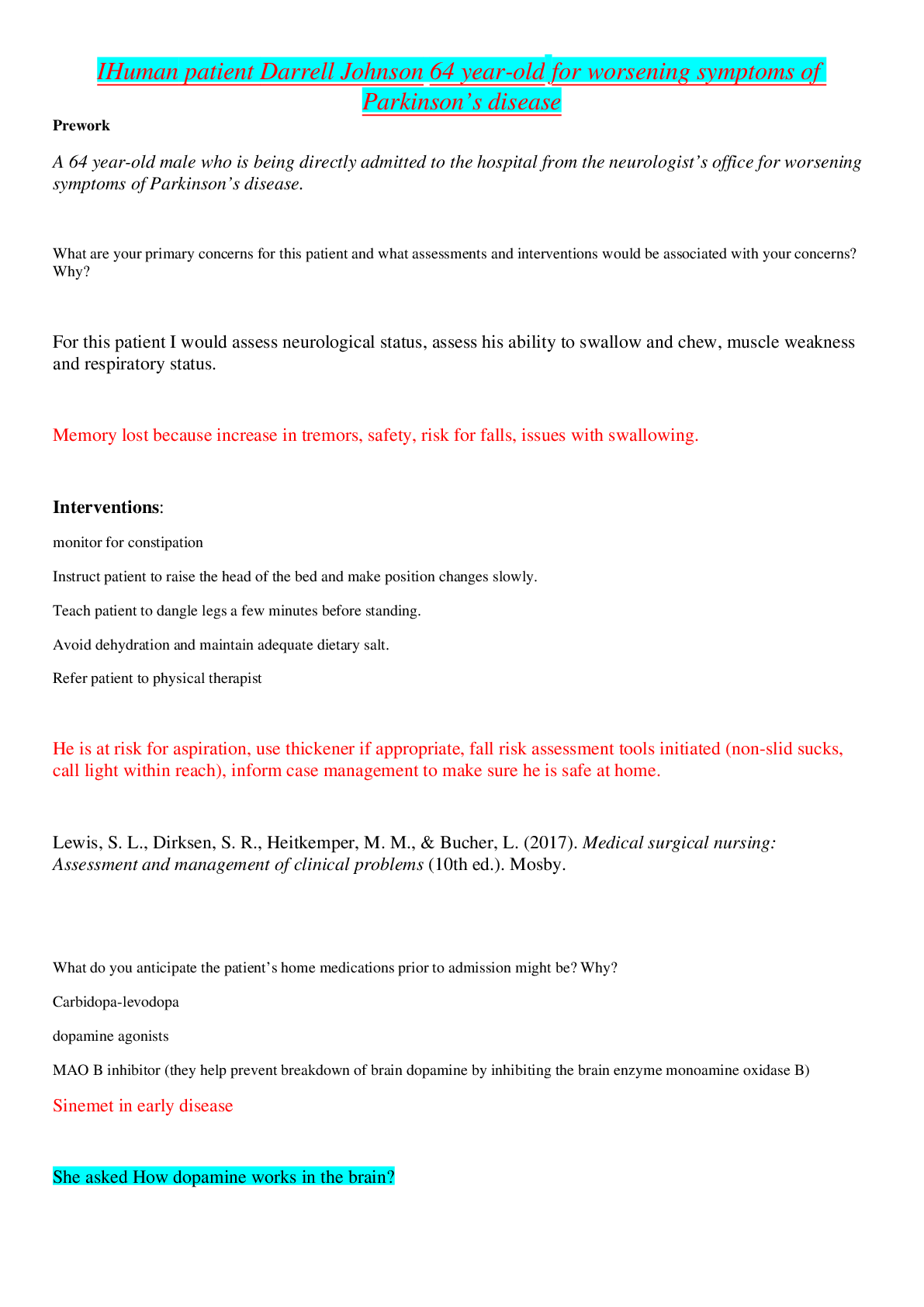
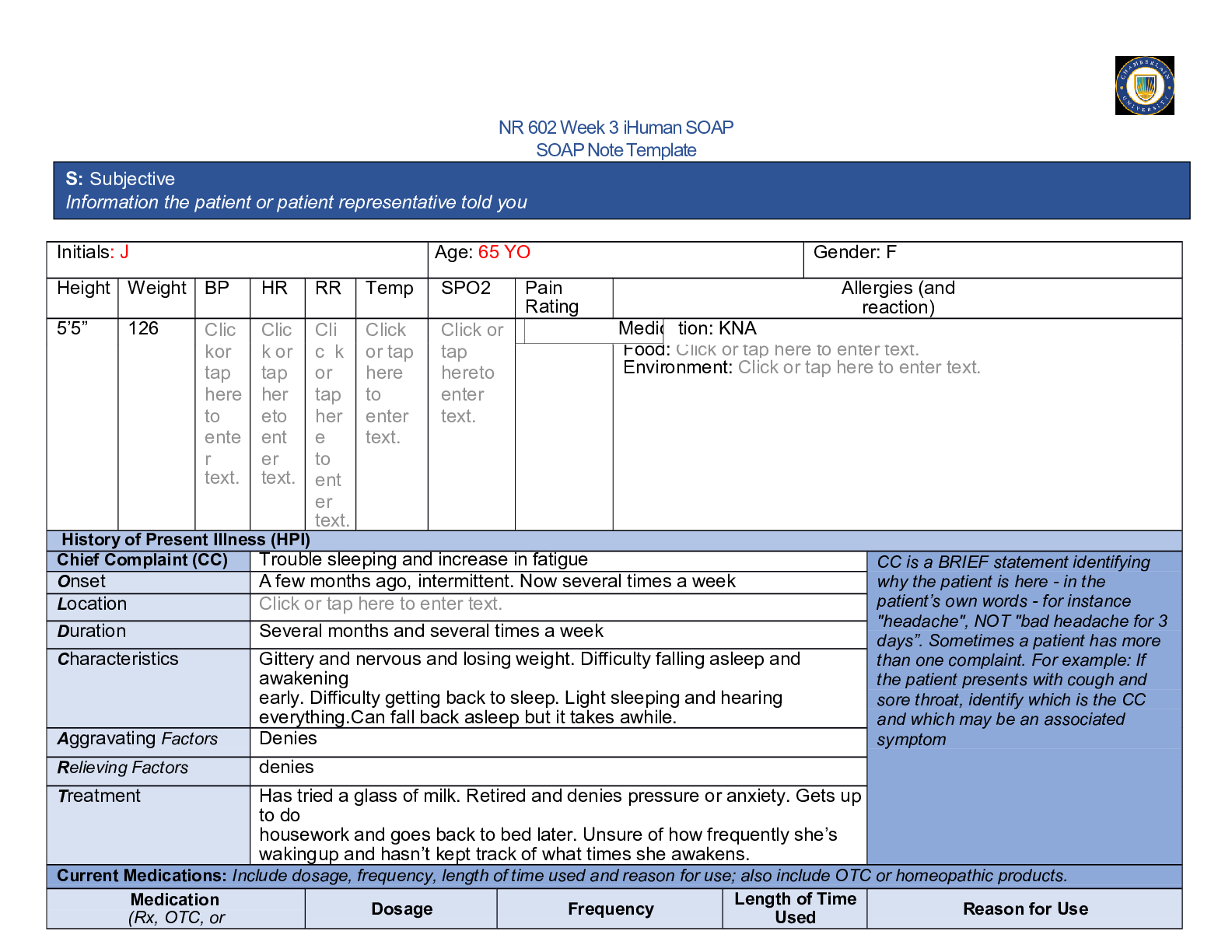
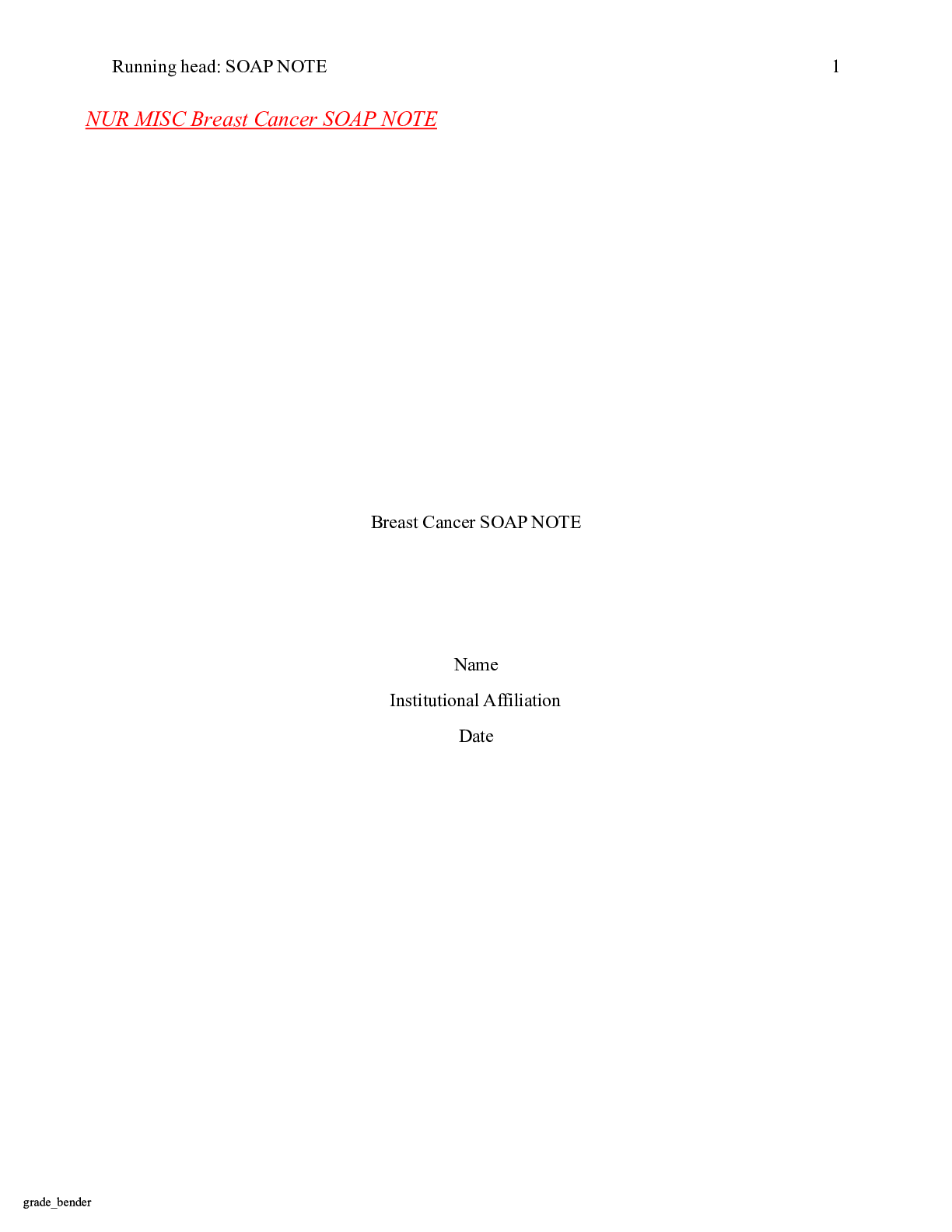


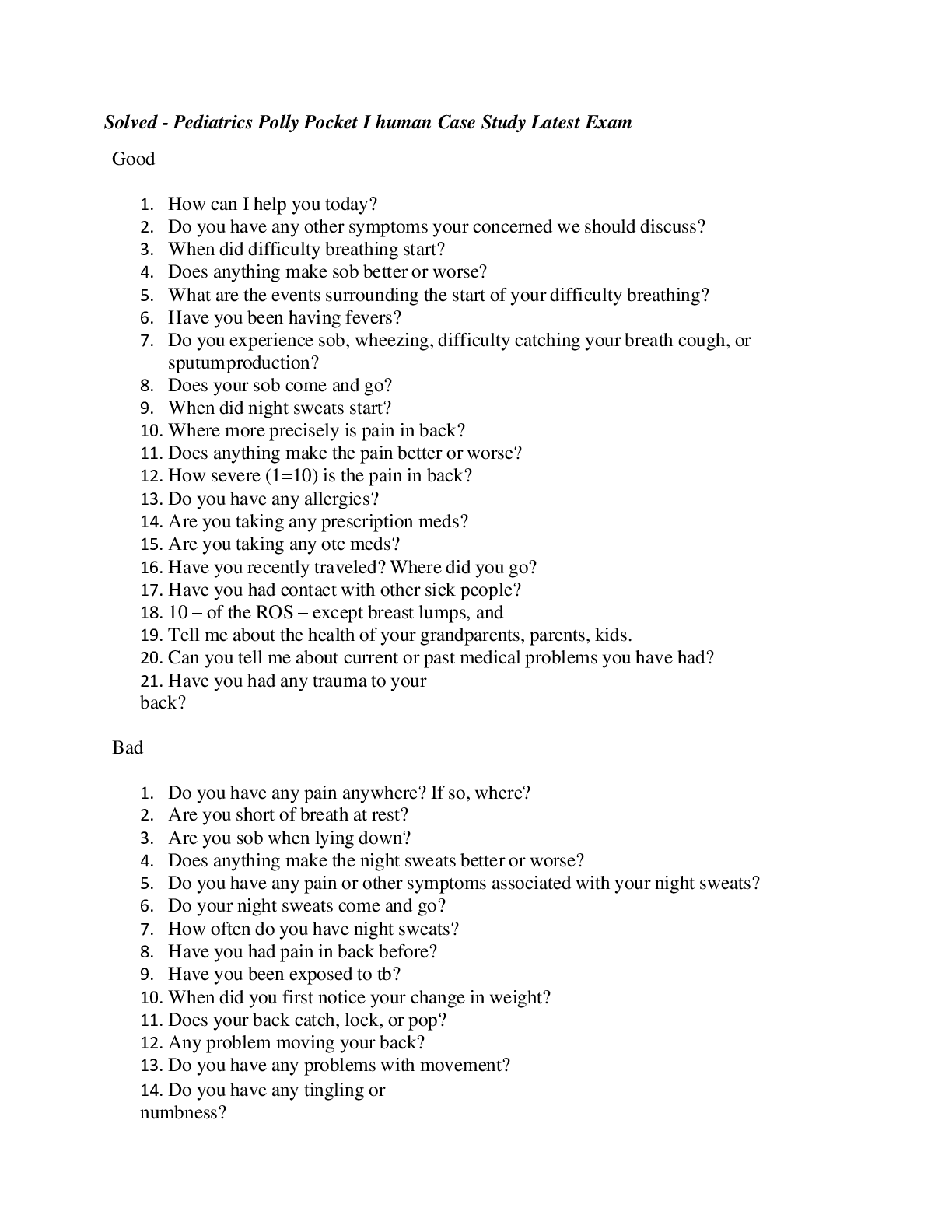


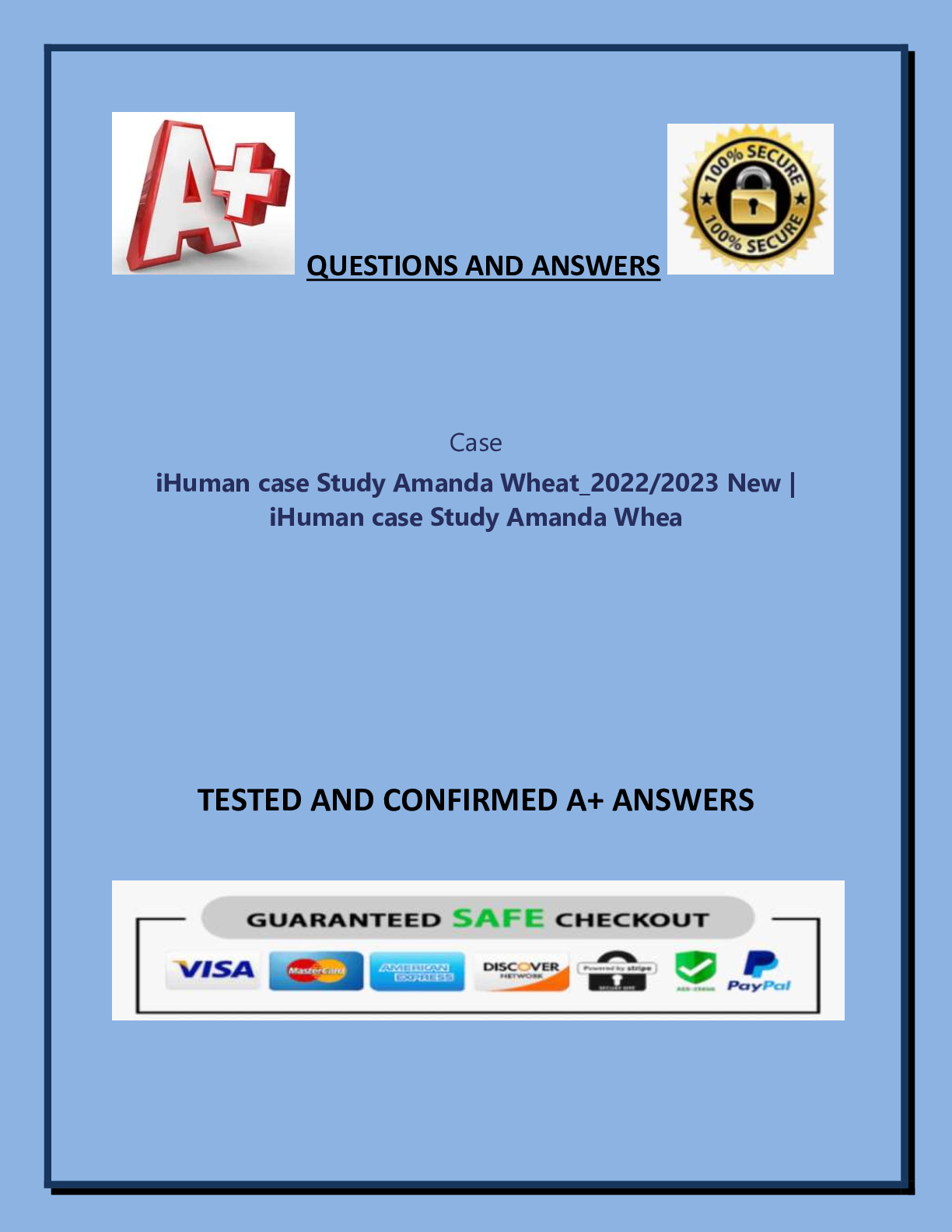
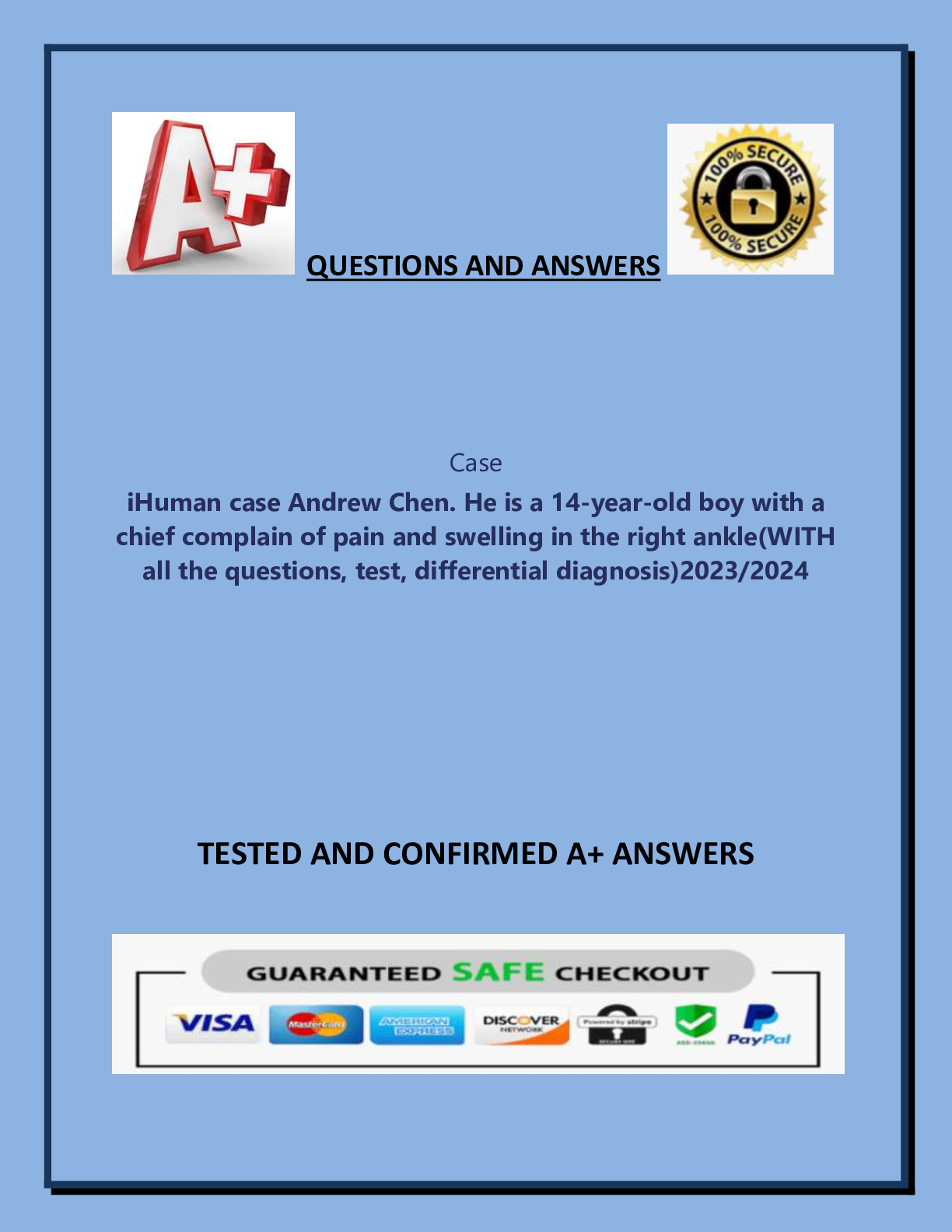
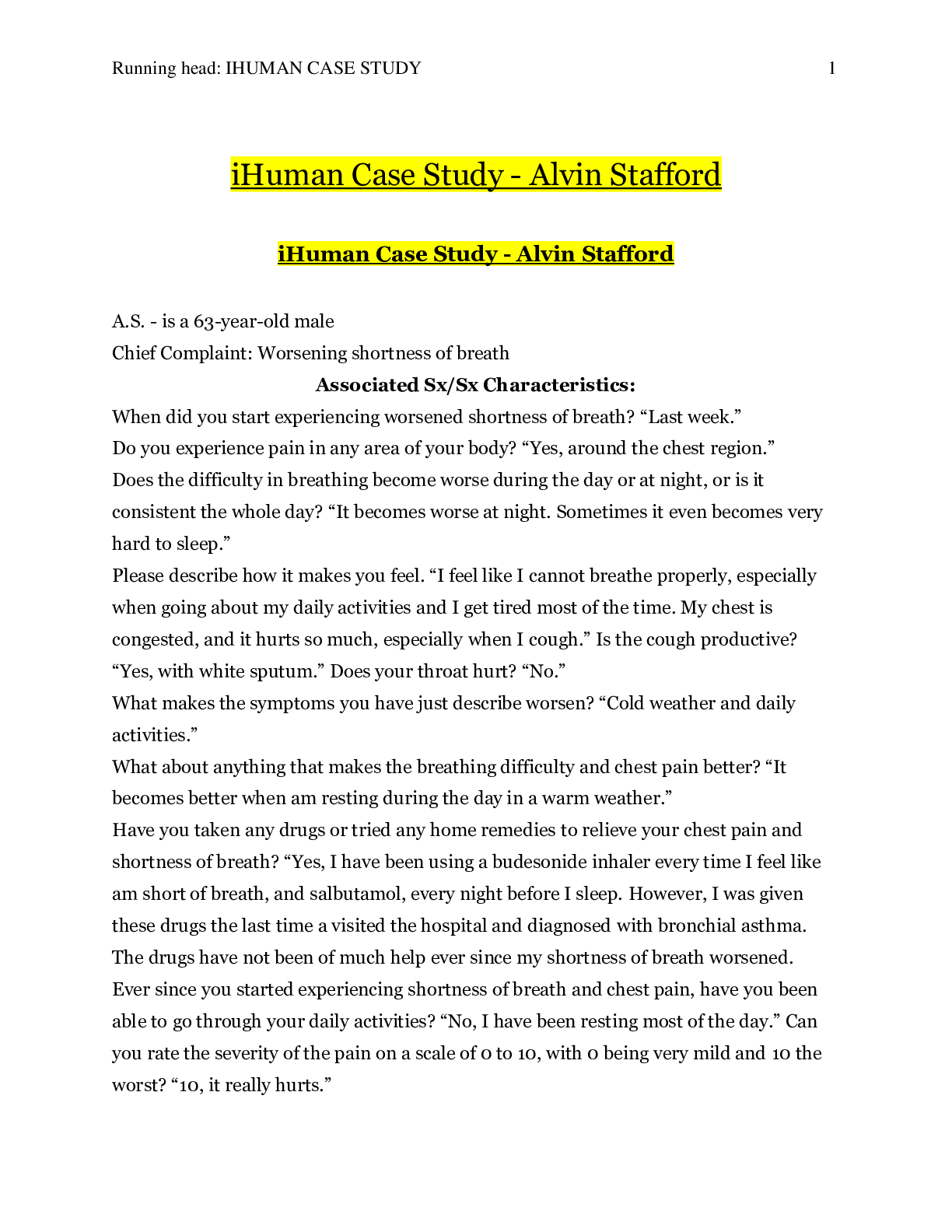

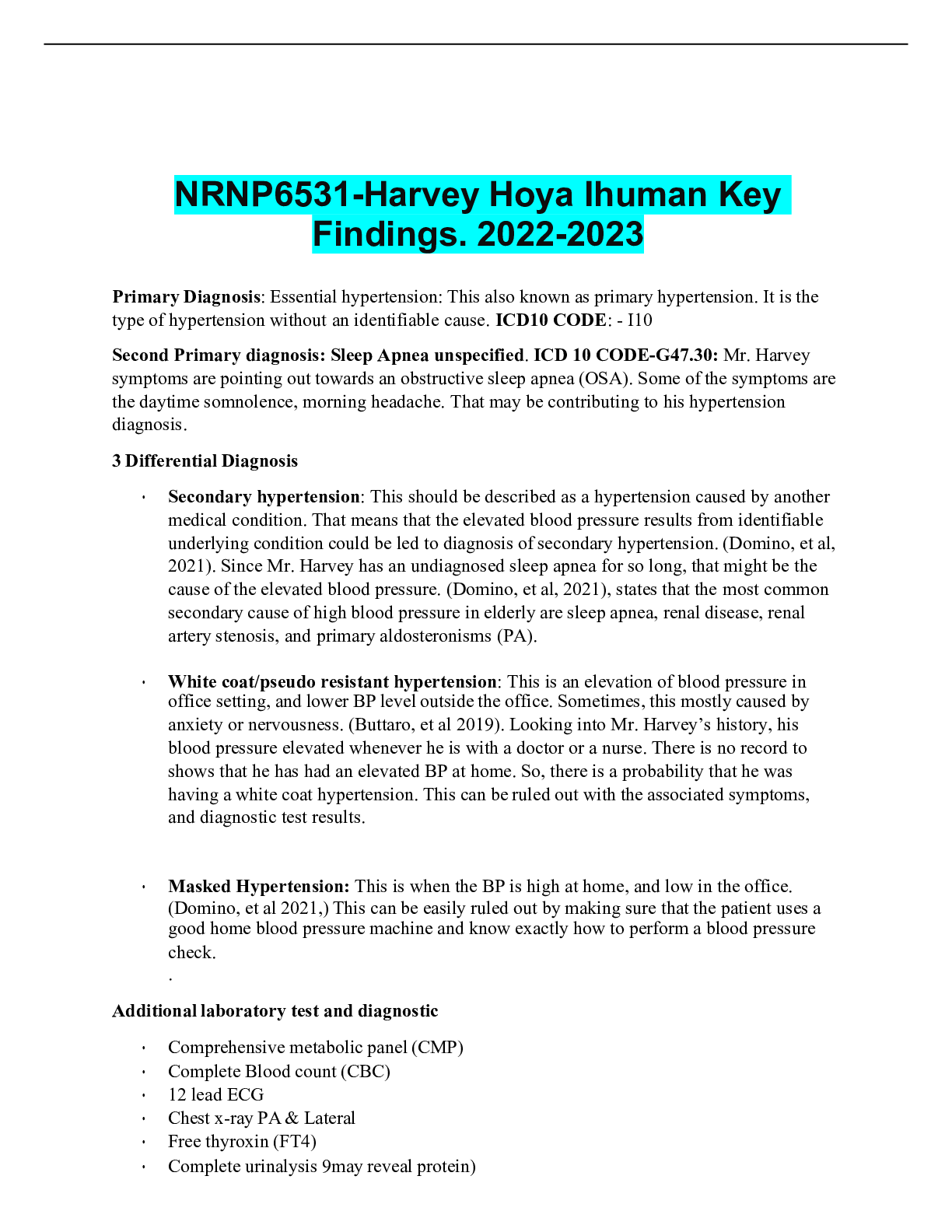
 2021.png)


